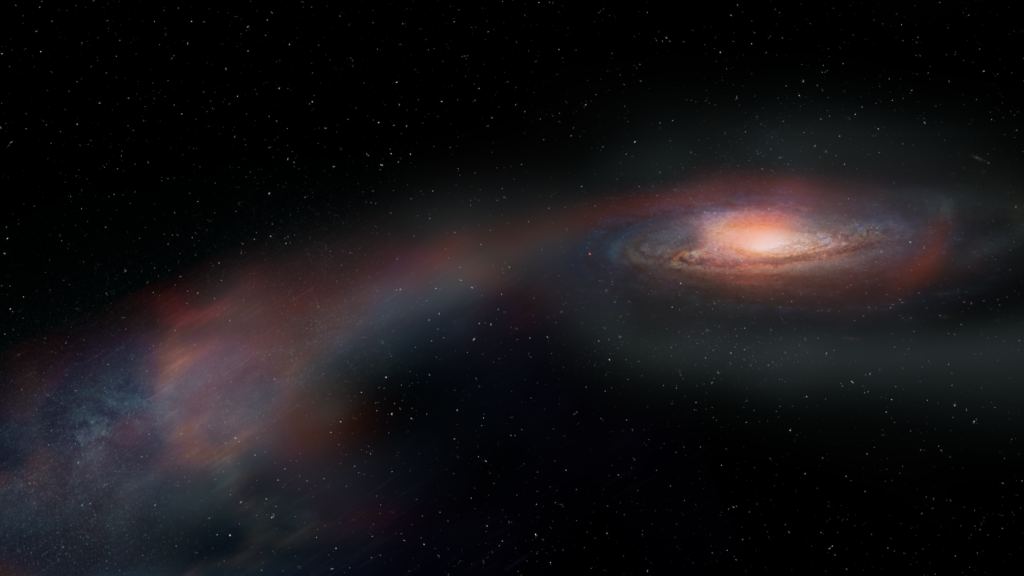What’s the recipe for forming stars? Yep, lots of gas and dust. Galaxies rich in these materials get to make a lot of stars. When the supply runs out, star formation stops. That’s what’s happened in the galaxy SDSS J1448+1010, but there’s a twist. The galaxy didn’t stop making stars because it made so many it ran out of material. No, that happened because it merged with another galaxy. That action flung most of the available gas and dust out of the galaxy entirely. Essentially, the galaxy to went “dormant” and ceased star-forming operations.
That’s the story that the Atacama Large Millimeter Array (a radio astronomy facility) in Chile discovered when it focused on this newly dormant galaxy. So, what’s the story here? How could a merger strip star-forming material away so completely?
A Galaxy Merger with a Surprise Ending
Galaxy collisions and interactions are a fact of life in the Universe. So is star formation, and the two are linked in interesting ways. The general story is that smaller galaxies merge to make larger ones. Large ones will collide and merge with other large ones, and sweep up smaller ones, too. One consequence of mergers is star formation. That usually happens as shock fronts move through clouds of gas and dust during mergers. They shove the clouds together, which starts the process of star formation.
All that will happen to the Milky Way in about five billion years, when it merges with the Andromeda Galaxy. It turns out that the smaller Triangulum Galaxy will get involved, too. And, right now, the Milky Way is gobbling up dwarf spheroidal galaxies. But, it hasn’t affected our galaxy’s ability to make stars. So, why did SDSS J1448+1010 lose so much material in its merger that it went dormant?

Credit: ALMA (ESO/NAOJ/NRAO), J. Spilker et al (Texas A&M), S. Dagnello (NRAO/AUI/NSF)
SDSS J1448+1010 is a massive galaxy born when the Universe was about half its current age. It has spent millions of years merging with another massive galaxy. That action ripped some amazing tidal tails out from the two galaxies. The tails were found during observations with the HST and ALMA. Those tails have about half of the entire system’s cold, molecular gas— exactly what’s needed for star formation. The tails contain about 10 billion times the mass of the Sun.
Changing Understanding of Galaxy Evolution and Star Formation
“What initially made this massive galaxy interesting was that, for some reason, it suddenly stopped forming stars about 70 million years ago immediately following a burst of star-forming activity,” said Justin Spilker, a Texas A&M astronomer and lead author of a paper about the system. “Most galaxies are happy to just keep forming stars. Our observations with ALMA and Hubble proved that the real reason the galaxy stopped forming stars is that the merger process ejected about half the gas fuel for star formation into intergalactic space. With no fuel, the galaxy couldn’t keep forming stars.”
This discovery sheds light on the processes that change galaxies. It also helps scientists to better understand their evolution. According to cosmologist and paper co-author Wren Suess, at the University of California Santa Cruz, the processes galaxies experience are under intense study. “When we look out at the Universe, we see some galaxies that are actively forming new stars, like our own Milky Way, and some that aren’t. But those ‘dead’ galaxies have many old stars in them, so they must have formed all of those stars at some point and then stopped making new ones,” she said. “We still don’t yet understand all of the processes that make galaxies stop forming stars, but this discovery shows just how powerful these major galaxy mergers are, and how much they can affect how a galaxy grows and changes over time.”
What’s Next?
How common are these galaxy tugs-of-war? Do they always shut down galaxy star formation processes? This discovery may force astronomers to change their views about how star formation progresses and when galaxies die. Now, they have to find and observe more dormant galaxies to see if this happens everywhere.
“While it’s pretty clear from this system that cold gas really can end up way outside of a merger system that shuts off a galaxy, the sample size of one galaxy tells us very little about how common this process is,” said David Setton, a graduate student in the department of physics and astronomy at the University of Pittsburgh and a co-author of the paper. “But, there are many galaxies out there like J1448+1010 that we’re able to catch right in the middle of those crashes and study exactly what happens to them when they go through that stage. The ejection of cold gas is an exciting new piece of the quiescence puzzle, and we’re excited to try to find more examples of this.”
These new observations show that while there are well-understood ways to shut down star formation in a galaxy, astronomers haven’t found all of them. “Astronomers used to think that the only way to make galaxies stop forming stars was through really violent, fast processes, like a bunch of supernovae exploding in the galaxy to blow most of the gas out of the galaxy and heat up the rest,” said Spilker. “Our new observations show that it doesn’t take a ‘flashy’ process to cut off star formation. The much slower merging process can also put an end to star formation and galaxies.”
For More Information
ALMA Witnesses Deadly Star-slinging Tug-of-War Between Merging Galaxies
Star Formation Suppression by Tidal Removal of Cold Molecular Gas from an Intermediate-Redshift Massive Post-starburst Galaxy

